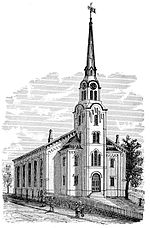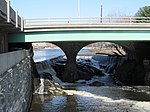Pawtucket River Bridge
1958 establishments in Rhode IslandArch bridges in the United StatesBridges completed in 1958Bridges in Providence County, Rhode IslandBridges on the Interstate Highway System ... and 5 more
Interstate 95Northeastern United States bridge (structure) stubsRhode Island building and structure stubsRoad bridges in Rhode IslandU.S. Interstate Highway stubs

The Pawtucket River Bridge is a twin span, six-lane highway bridge that carries Interstate 95 (I-95) over the Seekonk River in Pawtucket, Rhode Island. The original bridge was built in 1958 and rehabilitated in 1996. The bridge was demolished in 2012-13 and replaced with a new deck arch bridge that was completed in summer 2013. In November 2016, the bridge was officially renamed the James E. Doyle Pawtucket River Bridge in memory of the former mayor of Pawtucket, who died two months earlier.
Excerpt from the Wikipedia article Pawtucket River Bridge (License: CC BY-SA 3.0, Authors, Images).Pawtucket River Bridge
I 95, Pawtucket
Geographical coordinates (GPS) Address Nearby Places Show on map
Geographical coordinates (GPS)
| Latitude | Longitude |
|---|---|
| N 41.87336 ° | E -71.3844 ° |
Address
I 95
02860 Pawtucket
Rhode Island, United States
Open on Google Maps









